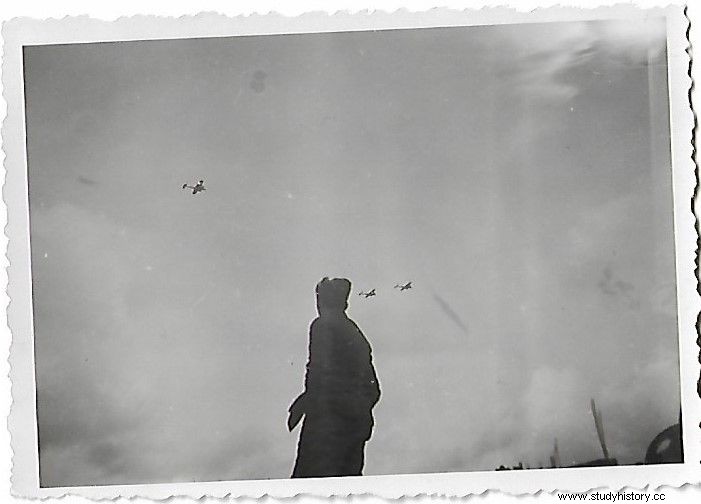
The Condor Legion Mainly made up of hunting, bombing, reconnaissance, anti-aircraft artillery and tanks, it carried out both combat tasks and advice for the Francoist army, providing a plus of modernity to its antiquated forces. With outstanding participation in the crossing of the strait of the African troops, the battle of Brunete or during the northern campaign, by October 1937 he will undergo a reorganization of his forces with the relief of his commands. After the exchange of his general Hugo Sperrle for Helmuth Volkmann and his chief of staff, Wolfram von Richthofen, for Hermann Plocher, new replacements and aircraft models were received to replace losses and withdraw those that had not given the desired performance. After this restructuring, the "legionary" forces of the air component will remain organized in:
- Führungsstab S/88, Command and General Staff, General Helmuth Volkmann and Colonel Hermann Plocher with Fi 156 A, Messerschmitt Bf 108 and Junkers W 34 liaison aircraft.
- Jagdgruppe J/88 with four fighter squadrons, two of Me-109s and two of the old-fashioned He-51s under Captain Gotthardt Handrick.
- Kampfgruppe K/88 with four bombing squadrons, « Mehnert, with He-111s in three of the squadrons and a handful of Ju-52s already relegated to night operations.
- Aufklärungsstaffell A/88, Reconnaissance Squadron, with DO-17E and He-45 aircraft under the command of Captain Joachim Gernndt.
- Seefliegerstaffeel AS/88, Maritime Reconnaissance Squadron, with He-59 and He-60 based in Pollensa under the command of Captain Hans Hefele.
- Flak Abteilung F/88, Motorized Anti-Aircraft Group with five heavy (Schwere) 88mm batteries, two light (Leichte) 20mm batteries supported by a 37mm section and a group of searchlights and rangefinders under the command of Lieutenant Colonel Lichtenberger.
- Luftnachrichten Abteilung LN/88, Motorized Airborne Transmission Battalion.
- Maintenance units and material park (Park) P/88, meteorology, services, health, etc. etc
The Condor Legion arrives at La Rasa Airfield
After this reorganization and with an eye on resuming operations around Madrid, the bulk of the Condor Legion's air component moved in mid-November 1937 to the airfield in La Rasa, 7 km from Burgo de Osma , while its headquarters will be established in Almazán. This location in Soria is not the result of chance and presented several advantages to the German unit. Thus, from this location both the Madrid and Aragón fronts could be covered, it was relatively close to Burgos and had the vital logistical support provided by the railway station attached to the airfield. This stop, on the now defunct Valladolid-Ariza line, was extremely important, as it allowed it to quickly receive supplies and spare parts both from its logistics base in León and from the ports of Vigo and Ferrol, where a large part of its cargo was unloaded. material. Lastly, the Burgense town with about 3,800 inhabitants, 1940 census, could provide lodging for troops and officers in a safe environment as it has been a national zone since July 1936.
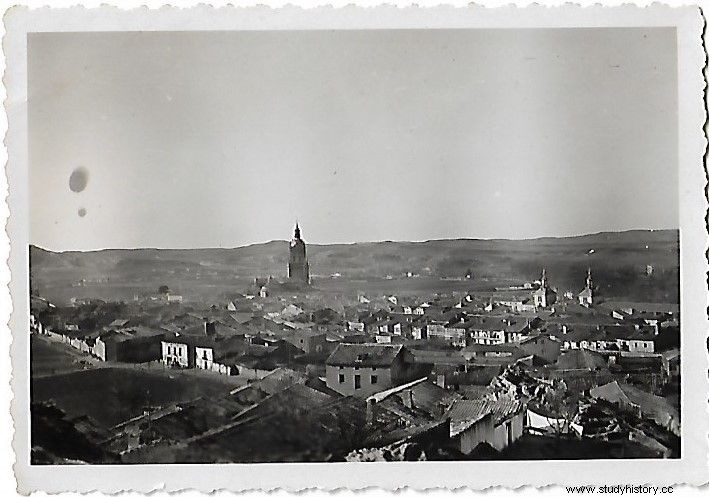
Regarding the airfield , currently disappeared, we can have a fairly precise idea of its dimensions and distribution thanks to various documents preserved in the General and Historical Archive of the Air Force. In one of them, dated 1940, it is described as a wide extension of land to the south of the railway station that would be framed to the west and south by the banks of the Duero and to the east by the road that goes to Navapalos, currently SW 1601. Irregularly shaped, it was 485 m long at its narrowest point, east-west, and 1,500 at its maximum, north-south axis, on sandy and somewhat soft terrain. In terms of facilities, it was, according to the use of the time, very Spartan, as it did not have electricity or water, and the garrison was housed in the buildings of La Rasa, with capacity for a company, and in a small three-room building. and dimensions of 12 x 5 meters. A fuel tank and three anti-aircraft shelters consisting of open trenches reinforced in brick and arranged in a zigzag would complete the set. Although this document is after the passage of the Condor Legion, it would be contrasted with the abundant existing photographic archive and a document signed by Kindelán himself that on September 12, 1937, perhaps anticipating its use by the Germans, granted an economic endowment of 4000 pesetas. for the construction of a barracks for the troops.
It will be in these facilities where the bulk of the air component of the Condor Legion will be installed from November 1937. By then it was already a seasoned unit that had practically almost replaced the devices of its beginnings, He-51 and J-52, by others much more modern and capable of facing with guarantees the ones of Soviet origin used by the republican aviation. At the same time, the General Staff will be located in the Soria town of Almazán. Once there, starting in December, it will have its own train made up of at least twelve wagons prepared as bedrooms, a dining room, offices and their corresponding anti-aircraft crew.
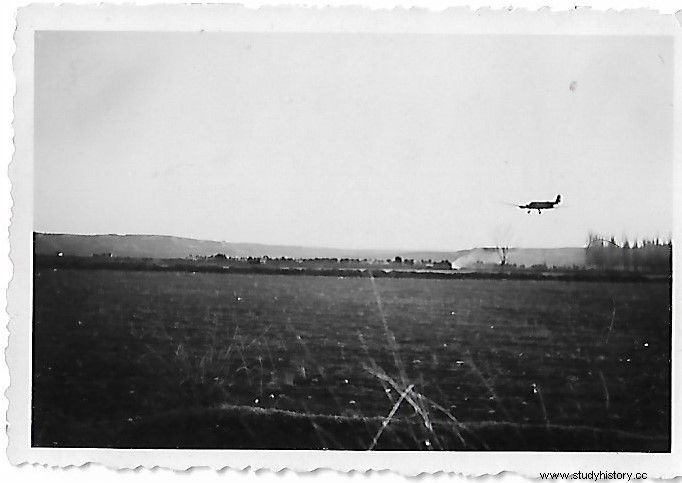
Focusing on Burgo de Osma, between November From 37 to January 38 we can verify, both through the existing bibliography and graphic documents, the presence or passage of a large part of the aircraft that the Germans could align at that time, 50 or 60 percent of the total.
Thus, to get an idea of its importance, the J/88 aligned in La Rasa 13 Me 109 B at the beginning of December 1937, which would rise to 25 by the 15th .
As for the K/88 bombers, their four squadrons had about 25 He 111s and 5 Ju 52s while the A/88 reconnaissance unit, always squadron-sized , initially had 3 Do 17s increased to 5 on the 15th and a solitary He 45 that would disappear from the charts a few days later. In addition to these models based on the aerodrome, it is known, thanks to photographs, of the passage through it of other aircraft such as He 51, Me 108 or Junkers W34 in liaison, meteorological tasks or simply in transit to other bases or advanced aerodromes.
Squads based in Burgo de Osma, La Rasa aerodrome.
- Jagdgruppe J/88 with two of its four fighter squadrons. The 1.J/88 led by Oberleutnant Harro Harder until December 18 when he will be relieved by Oberleutnant Wolfgang Schellman. and 2.J/88 commanded by the Oberleutnant Günther Lützow. Both will have the brand new single-engine Messersmitt 109 B, which in this and subsequent versions will be the best fighters in the contest.
- Kampfgruppe K/88 with its four full bomber squadrons led by the Major Mehnert. They will have twin-engine He-111 E “Pedros” and a handful of Ju-52 “Pablos” already assigned to night or secondary operations for their missions.
- Aufklärungsstaffell A/88, Reconnaissance Squadron equipped with twin-engine DO-17E and F “Cod” and single-engine He-45 “Turkeys” under the command of Captain Joachim Gernndt.
All of them would be joined by the support units, without which it would be completely impossible for them to operate, with outstanding communications, mechanics, logistics, administration and for their protection the cannons of the F/88. Specifically, the heavy battery 2/F88, Captain Hein, will be in charge of the defense thanks to its 4 pieces of 88/56 mm, no less than a pair of light 20/65 mm Flak 30 cannons and several machine guns of 7.92 x 57 mm model Maxim MG 08 in anti-aircraft mounting. We cannot fail to mention the importance that the arrival of the 88 mm guns had in our civil war and later in World War II. These were modern pieces, on a cruciform gun carriage that, endowed with a high muzzle velocity, could hit air or ground targets at great distances and with a high volume of fire provided by their semi-automatic closure. A key to their success is undoubtedly due to their excellent precision, for which they had a system where the aiming was carried out automatically for the battery thanks to a cable system that, from the direction of fire, provided a signal to the pieces where some lights were turned on that the pointers had to follow.
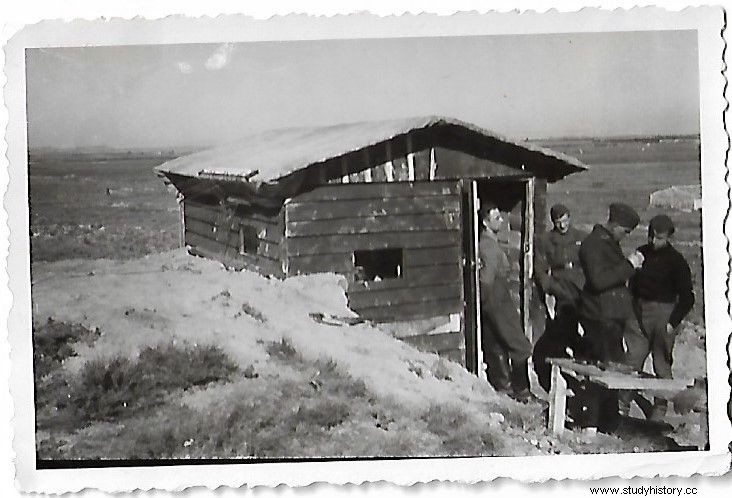
Obviously we will not only find German personnel since these will have the support of national soldiers in support and security tasks. In order to encrypt their presence, we have a troop situation report from the Aviation Arm of the so-called Unit 31 destined for the Burgo de Osma aerodrome. In this document, dated January 1, 1938, the endowment is quantified at 115 troops, between corporals and soldiers, plus five sergeants, a brigade, Lieutenant Cristóbal Zambrana Carretero, Lieutenant Cesar Sanz Ruano, Lieutenant Tomas Herreras Coello and Captain D. Manuel Pújales Villasante as chief officer.
The Condor Legion in Burgo de Osma
In November 1937, Burgo de Osma was a small town with less than 4,000 inhabitants that had belonged to the so-called national zone since the beginning of the Civil War. Away from the front line, life in the Burgense town passed, in a similar way to that of many others in the rear, on the day of the single dish, rationing, acts of patriotic praise such as the one organized on June 19 to celebrate the taking of Bilbao or donations for the war effort. Regarding infrastructures this historic episcopal seat had, despite the small size of the population, a cathedral, jail, courthouse and other emblematic buildings such as the San Agustín Hospital, the old University and a large seminary, being precisely in these last two buildings where the legionnaires will land. Thus, soldiers and non-commissioned officers will stay in the seminary while part of the administrative apparatus will occupy the 16th century building that had housed the old University of Santa Catalina. For the officers, to the use of the time, private houses assigned by the so-called Accommodation Commission will be allocated.
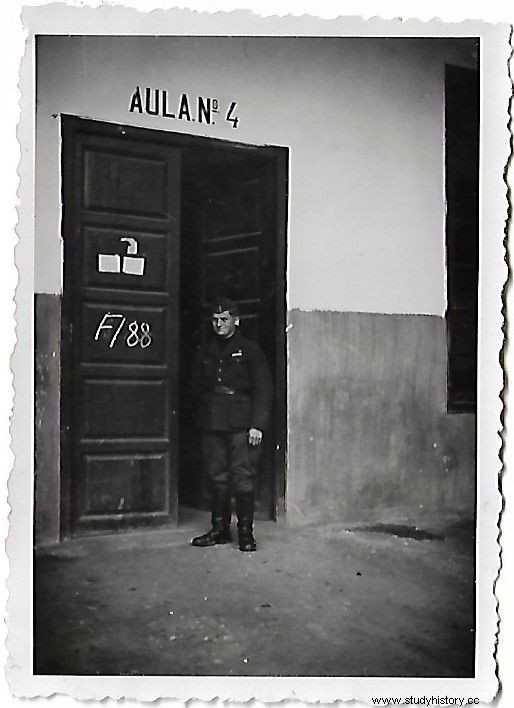
Destined to seek accommodation for the troops in its path for the people, this organization has left as a testimony of its work different material such as edicts and receipts. Thanks to them, we can assume that with the arrival of the Germans there was a certain pressure when it came to finding useful houses, since throughout 1937, there were numerous municipal districts in which residents were required to notify the presence or absence of soldiers in their homes. A good example of this is the writing that the mayor D. Enrique Casado Rodrigo issues during the stay of the German legionnaires at the end of that same year.
Another interesting aspect is the requests for material destined for the lodging of troops in the Burgo. Beds, mattresses and blankets were required from the population during March 1937, leaving in exchange the corresponding "slip" of the requisition or relations of the confiscated material. This date coincides with the arrival in the town of Italian fighter squadrons , 1st and 3rd Squadriglie, equipped with FIAT CR.32 “Chirri” biplanes, which may explain this sudden and unexpected need for beds. We have an example of these documents in one issued by D. Zenón Jiménez Ridruejo in which he presented a sworn statement on March 18, 1939 stating that two years earlier, on March 17, 1937, he delivered to the Accommodation Commission:cot wooden with headboard, 135 cm nickel-plated bed, 90 cm iron bed, two 135 cm iron beds and two 90 and 135 cm wooden bed bases.
We do not have the number of troops deployed to Burgo de Osma, however we can deduce that at the time of maximum activity, taking into account the crew required per aircraft model, 4 in the He111, 3 in the Do 17 and 1 in the Me 109, there would be about 150 flight personnel. They would be joined by the gunners of the 2/F88, 2 for each MG 08, 5 for each 20 mm piece and 10 for each 88 mm cannon, plus mechanics, drivers and service personnel with an estimate of another 150 men. Thus we can assume that the German detachment would be made up of approximately 300-350 soldiers.
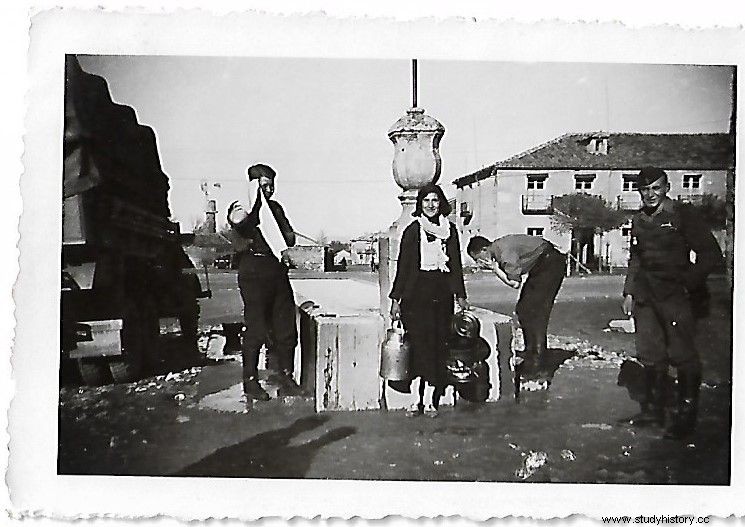
The troops are installed in the town, evidently they are related to the population of Burgos and to know their day to day we have a testimony of great value collected by Javier Nicolás for the local magazine Arévacos . It is about the memories of Bernardo de Blas who, working as a hairdresser with his father and a partner of his, ended up exercising his trade for the Germans. Bernardo was with the legionnaires since his arrival, November 37, continuing with them until April 38 in Zaragoza, the date on which he is called up. From his time in the Burgo he tells how he worked for them as a barber and hairdresser on the ground floor of the seminary where, in exchange for his work, he received a higher payment than his regular parishioners. It is precisely in the seminary building where, according to his own words, in addition to lodging, the Germans had their kitchens, attended by his own staff. From the food he remembers how it had caused him amazement to see how troops and officers had the same ranch that they accessed by making an orderly queue without distinction of ranks.
Another point that he remembers, related to maintenance , is the periodic arrival of a Junker 52 trimotor. According to his account, this device, in addition to the mail, brought different products directly from Germany, such as beer, not so common in Spain at the time, or butter. This point is corroborated by the fact that the logistics of the Condor Legion were organized independently and not only was the Export beer brought from Germany, since even bottled mineral water, surely to prevent disease, was supplied by ship from the Reich. to their base ports in Spain.
In personal relationships he defines them as serious, orderly and disciplined people, demanding in terms of punctuality, but always very correct. This image has remained widespread in the area as a counterpoint to the more "chaotic" image left by the Italians who had preceded the Germans a few months earlier.
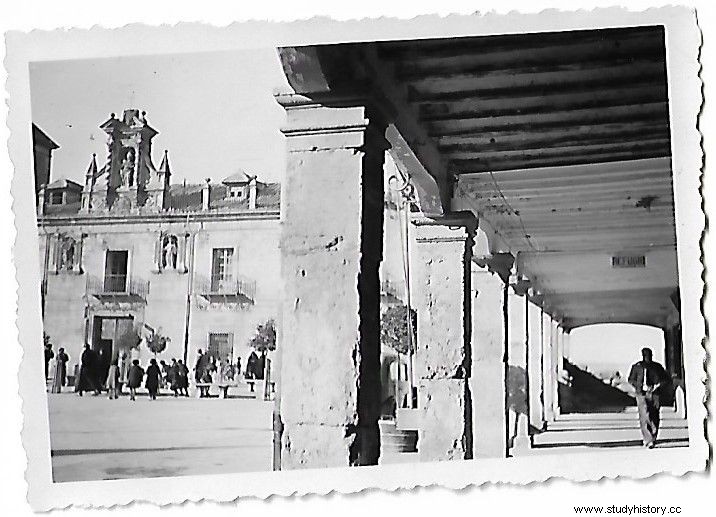
To finish with Bernardo's testimony, he does reference to a person who died at the aerodrome during November 1937. In fact, on the 28th of that month, non-commissioned officer Karl Lütkeduhme was discharged due to accidental death when disassembling a machine gun or automatic weapon from an airplane. This fact has been fixed in the Burgense imaginary thanks to the existence for years of a small monolith on the road from La Rasa to Navapalos where the name of the soldier and the date of his death could be read. However, the passage of time and the "disappearance" of this wake has blurred the memory of him and is currently erroneously cited as the tomb of the German pilot or German.
Air operations from La Rasa aerodrome
Evidently the presence of the German aviators was not due to a courtesy visit and they carried out numerous combat missions from La Rasa that were increased by the unexpected offensive that the Republican troops they launched on Teruel at the end of 1937. On December 15, Líster's government troops broke the front around Teruel's capital, which would be surrounded two days later, to give rise to a harsh house-to-house battle within its urban area. On the 23rd, Franco decides to suspend his offensive plans around Madrid and provide support to the committed garrison under the command of Rey d'Harcourt, which was still resisting around several strong points in the city. For this he will mobilize the Army Corps of Castile and Galicia, Generals Varela and Aranda, as well as the main nucleus of the national aviation to which the Condor Legion belonged.
Thus, during their time in Burgo de Osma, the German aircraft will have a first period with reconnaissance operations and a second, much more intense stage, marked by a harsh winter and the actions around the battle for Teruel . In order to coordinate its units, the train with the S/88, General Staff, departs from Almazán to Calamocha, where at the end of December it will be followed by the J/88 fighter units. As for the K/88 and the A/88, they will continue in La Rasa where they will fly multiple missions in support of General Aranda's men. Good proof of the intensity of these actions is a note included in the operations report of January 7, 1938, where the volume of explosives launched by the K/88 is estimated at 306 tons and those used by the A/88 at 40 tons of bombs. /88 in the period between December 27 and January 7. Despite this effort, on January 8, Rey d'Harcourt will surrender along with the last defenders of the seminary, moving on to land and air operations to try to take the city by means of a movement to the north of it that will culminate in the battle of Alfambra and the capture of the city on February 22, 1938.
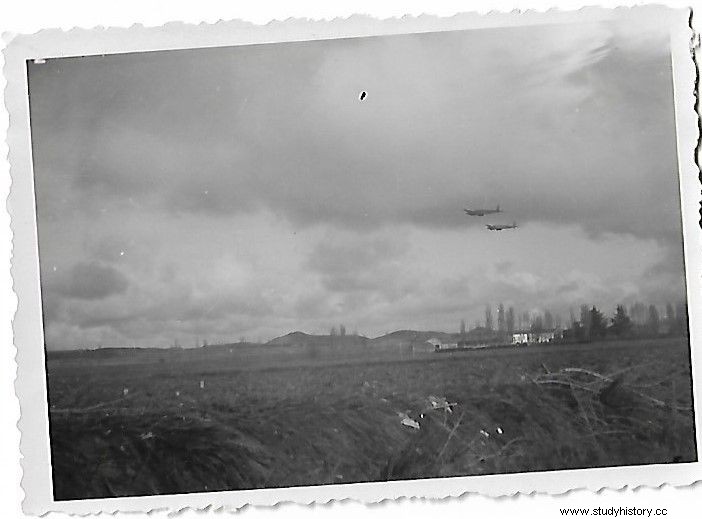
Throughout these actions the K/88 will lose a He 111 with its entire crew –Leutnant Friedrich-Karl Beucke, Leutnant Heinrich Klein, Feldwebel Anton Bergmann, Unteroffizier Fritz Brühl and Obergefreiter Alois Ehlen– on December 10 during a mission over the Candasnos aerodrome. This loss will be followed by that of another Heinkel 111 B, number 25-32, which after a mission over Teruel on December 17 will carry out, due to adverse conditions atmospheric, an emergency landing in Guadalajara falling into government hands. This device, in fairly good condition, will be inspected by French technical personnel before being disassembled and shipped together with an Me 109 B to the Soviet Union. Finally, a He 111 of 3/K88 will be shot down by the republican fighter over Teruel on January 26, 1938.
As we can see, the harsh winter of 1937-1938, with temperatures in Teruel of 20 degrees below zero, marked the operations, being the cause of many casualties in combat missions and complicating the task of the maintenance teams on the ground, already weighed down by the continuous movement of the planes between different advanced aerodromes, is extremely difficult. Thus, on the slopes of La Rasa, subjected to the Sorian cold, the German mechanics will be forced to chip the ice from the wings of their aircraft or try to heat the frozen cylinders of their engines with blowtorches.
Despite these cares, the casualties among crews and devices caused by accidents will take their toll on the Condor Legion during their stay in Burgo de Osma. On December 5, 1937, a Heinkel 51, the 2-85, piloted by Captain Heinrich Neumann, military doctor of the Condor crews, made his approach to the La Rasa aerodrome during a visit to the troops. However this will not be another routine flight as his personal He 51, decorated on both sides of the fuselage with a white circle inside a black one, will stick its nose during landing. Fortunately, this accident, probably due to too muddy terrain, would not have major consequences and the astonished doctor was given another device, He 51 2-102, with which he continued his visits until his return to Germany in February 1938. After spending a year and a half in Spain without a single scratch, luck will continue to smile on her, since enlisted in the elite German paratroopers, she will manage to survive the Second World War and retire years later as a doctor in the reborn armed forces of the German Federal Republic .
It will not be the only accident, on January 8, 1938 a transport Ju 52 making the León-Burgo de Osma route crashed due to bad weather against a mountain, Peña Cervera , about 20 km from Lerma. The Unteroffizier will die on impact. Paul Schick and the Obergefreiter Erwin Hoster, both belonging to 2/K88.
Air raids and passive defense in Burgo de Osma
All this aerial activity, being the Condor Legion a vital force for the war effort in the so-called national Spain, could not go unnoticed by the Republican aviation and, although it is not confirmed a direct attack on the aerodrome, some incursions by La Gloriosa do appear in the reports of the time. Thus, on December 19 at 1:30 p.m., 15 republican aircraft entered the national zone through Jadraque and, after approaching Burgo de Osma, turned south and bombed Cogolludo. Another incident that is cited is the raid on the airfield of a reconnaissance plane on January 28, 1938 that is answered, apparently without result, by the anti-aircraft pieces of 2/F88.
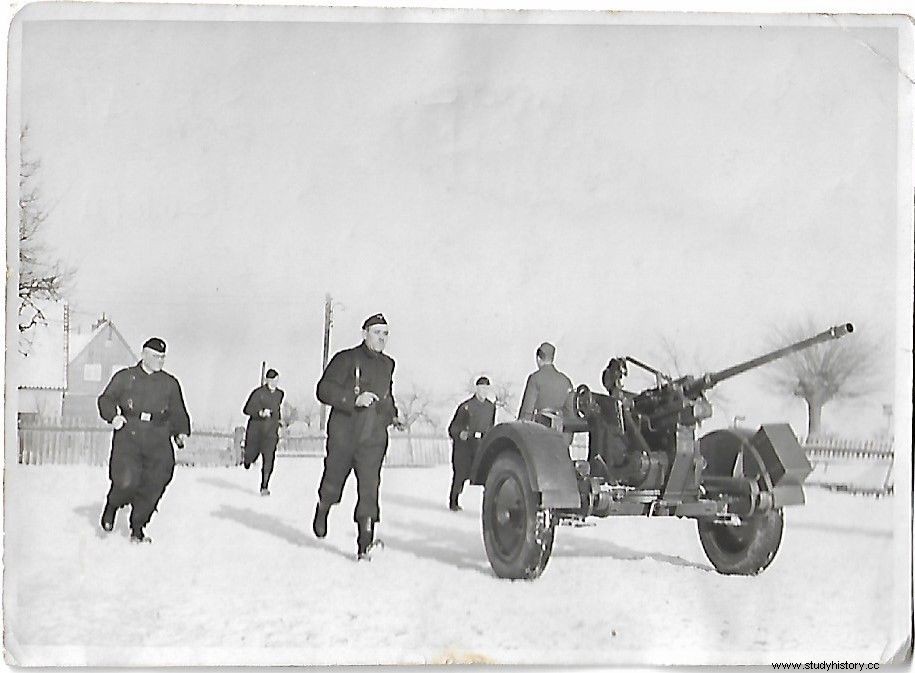
Evidently these actions are a sign of the danger involved he Burgense town the proximity to a military installation of such relevance at the time. Maximized by the lodging of the troops in the town, this should not have been taken lightly by the local authorities and surely measures aimed at passive defense should have been taken. Dedicated to the protection of the population in the event of a bombardment, it used to be based on darkening actions at night, aerial alarms and the usual anti-aircraft shelters. Although we currently have no written record of these activities in the municipal archives, we do have a photographic testimony taken by a legionnaire and dated January 1938 that shows the signage, and therefore the presence, of a refuge on one of the sides of the Main Square. Specifically, it would be located in the basement of a ground floor in the arcades and which today occupies a well-known restaurant in the area.
End of operations, the Condor Legion leaves Burgo de Osma
On February 24, 1938, Franco decided to exploit the success achieved in Teruel and take advantage of the ground gained to launch a new campaign. With this new operation, against the opinion of General Volkmann, commander in chief of the Condor Legion, he was leaving Madrid as a priority objective for an advance on the Mediterranean to split the coastal areas in two, still in Republican hands. Evidently this plan will have repercussions on the German deployment and by the end of February 1938 the A/88 reconnaissance apparatus left for Buñuel while the K/88 bombers left Burgo de Osma for good to move to Alfaro. .
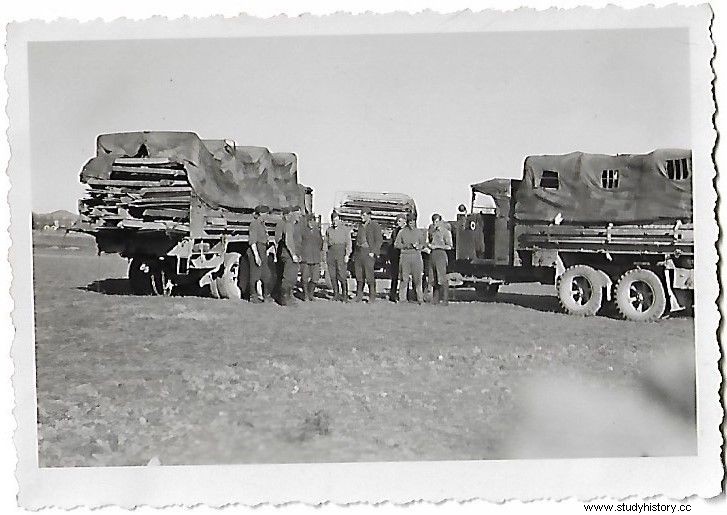
The departure of the planes will be followed by the staff from land and from 2/F88 in the direction of Alfaro. A legionnaire will leave a written record of this "movement" on the back of the photographs where the loading of the trucks and their departure from the University of Santa Catalina can be seen.
Testimonies of the past
After the departure of the Condor Legion and with the movement of the front to the east, operations at the airfield dwindled to such an extent that at the end of the Civil War it practically fell into disuse. Thus, in May 1941, its dismissal was proposed, which would be ratified on June 4, 1941 by the Chief of Staff D. Eduardo González Gallarza, once again passing ownership of the land to its original owners.
Currently, apart from its memory, little remains of that rustic airfield that for a few months was so important in our civil war. Today almost all of the plain, used for more than 80 years as a track, is occupied by an industrial apple plantation and apparently nothing gives us a glimpse of what it once was. However, a closer look will allow us to discover the old railway station attached to the field, some old buildings of the time in the roundabout of La Rasa and even one of the anti-aircraft shelters in the field. This simple construction, a mere trench reinforced in brick, still allows us to glimpse its characteristic zigzag through the undergrowth next to the road to Navapalos. Next to it we can see the foundations of a small building that, although we cannot guarantee it, could correspond to the one tendered for 4000 pesetas. in September 1937.
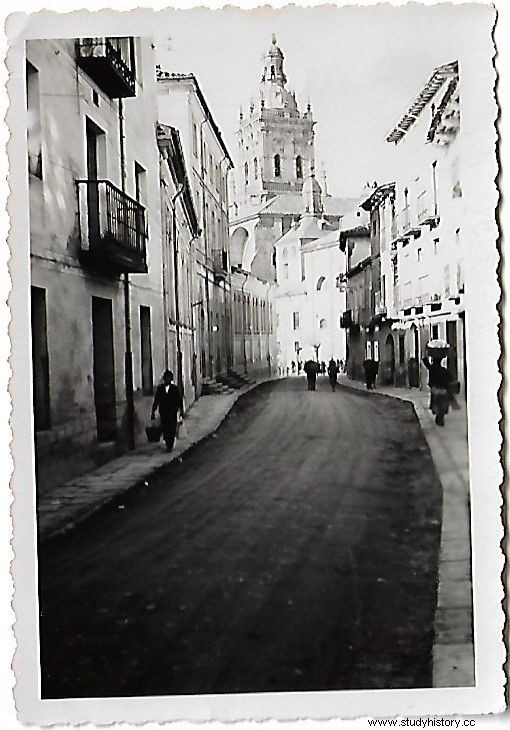
In El Burgo, its historic center maintains the structure and buildings that the German soldiers were able to visit and photograph with their Leicas cameras. In fact, there is ample graphic testimony of its passage through the town that collects snapshots of war themes or images where locations of the panoramic views of the town, landscapes of the area or emblematic buildings are easily recognized. Of these, the seminary used as accommodation by the Germans is still in use today, while the old University of Santa Catalina, administrative center of the Condor Legion, is a hotel establishment.
To end this “legionnaire” tour we still have the “disappeared” stele of non-commissioned officer Karl Lütkeduhme. Removed from its original location, on the edge of the So 1601 highway towards Navapalos, and contrary to what many people from Burgos think, it has not disappeared and can currently be seen next to the door of the small La Rasa cemetery. This small monolith, although in a very poor state of conservation, still allows us to read its inscription, very similar to other similar monuments scattered throughout the national geography.
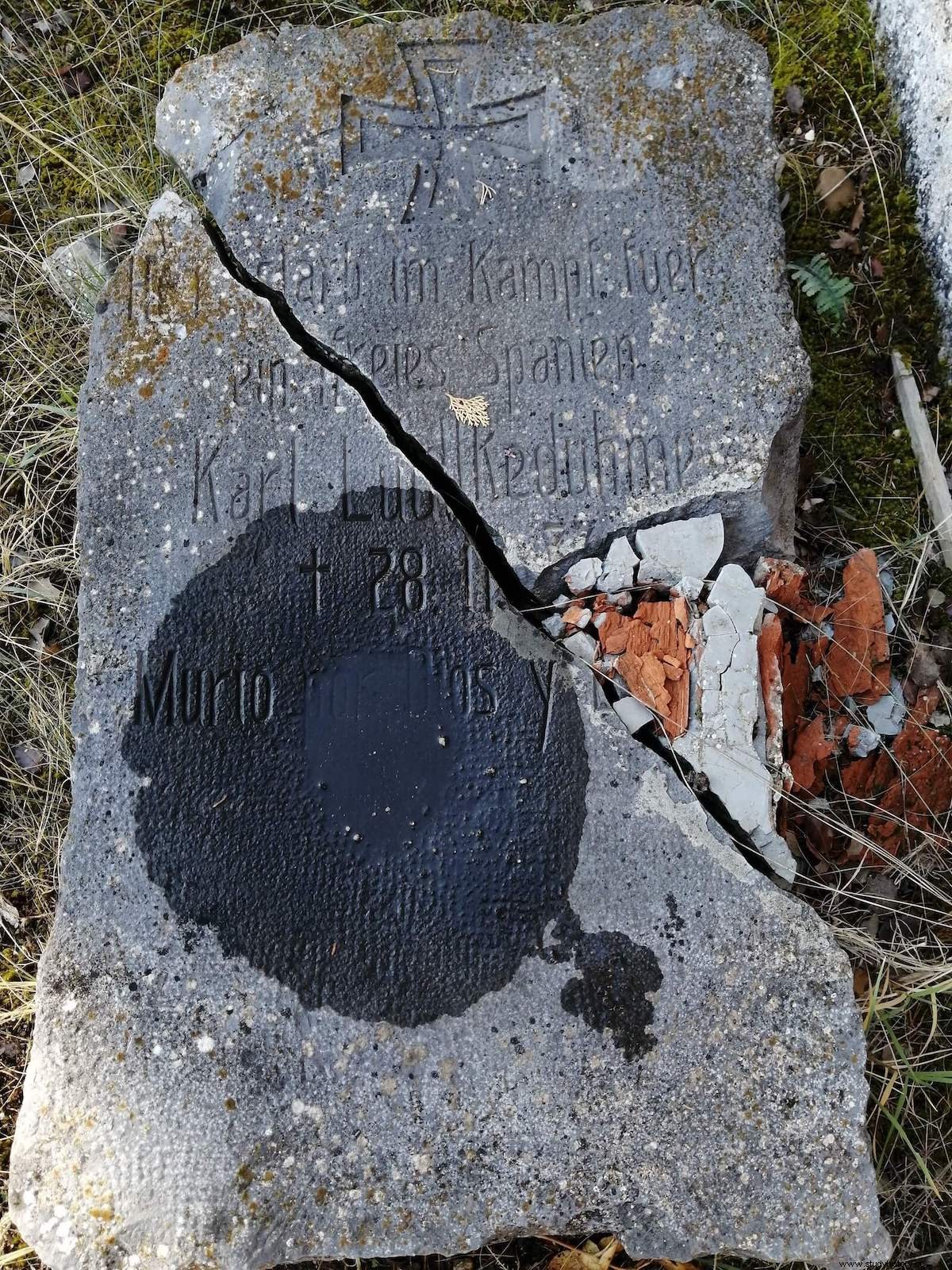
Bibliography and acknowledgments
Thanks for their time and patience to the staff of the Burgo de Osma Public Library and municipal archives and to the aeronautical historian D. Blas Vicente Marco.
- Sentinels of the Air, Anti-Aircraft Group of the Condor Legion . Galland Books.
- History of Spanish Aviation . Institute of Aeronautical History and Culture.
- The Condor Legion , Collection Histoire de l'Aviation No. 7. Edit Lela Presse.
- The Condor Legion . Osprey Publishing.
- The Condor Legion Spain 1936-39 . Saint Martin.
- Condor Legion. His story 60 years later . Battlement.
- Arevacos Magazine , testimony of Bernardo de Blas collected by Javier Nicolás.
- Ares Magazine , «The vehicles of the Condor Legion». Galland Books.
- Documents cited:General and Historical Archive of the Air Force, Burgo de Osma-Ciudad de Osma Town Hall Municipal Archive.
Annex:the planes of the Condor Legion in Burgo de Osma
The Heikel He 111, Dornier Do 17, Junkers Ju 52 bombers and the Messerschmitt Me 109 fighter are the aircraft that stand out during the passage of the Condor Legion through Burgo de Osma. And they will be the ones who, modified after the experience gained in Spain, make up the bulk of the Luftwaffe at the start of World War II.
For identification purposes, indicate that the German aircraft, like those of the Francoist or Italian aviation, sported the mobile part of the tail rudder in white crossed by a Cross of Saint Andrew in black. On the planes of the wings, both upper and lower, they showed black circles with white crosses, while their identification codes could be read on the sides of the fuselage. Estos códigos se iniciaban con el número asignado al modelo de avión, 25 para los He 111, 22 en el Ju 52, 6 sobre los Me 109 y 27 de los Do 17. Continuarían con un disco negro seguido para finalizar por un número correspondiente al orden de ese aparato en España.
Heinkel He 111 B y E “Pedro”
Bombardero bimotor diseñado por los hermanos Günther a principios de los años 30. Construido originalmente como un avión correo y transporte rápido para eludir las prohibiciones del Tratado de Versalles presentaba unas características optimas que fueron aprovechadas por la incipiente Luftwaffe. En febrero de 1937 llegaron a España las primeras unidades del modelo B a las que en marzo de 1938 se unirán la versión mejorada tipo E. Aproximadamente un centenar combatirán en los cielos de España donde darán el relevo a los tremendamente vulnerables Ju 52. Al término de la Guerra Civil se entregaron unidades del modelo B pero la necesidad de mejorarlas impulsó un acuerdo entre CASA y Heinkel para la fabricación bajo licencia de su versión H. En un principio dotado de motores alemanes, CASA 2.111, en los años 50 fueron modificados unos 70 aparatos con motores Rolls-Royce Merlin. Estos modelos participaran en la Guerra de Ifni e incluso en el rodaje de la película La batalla de Inglaterra .
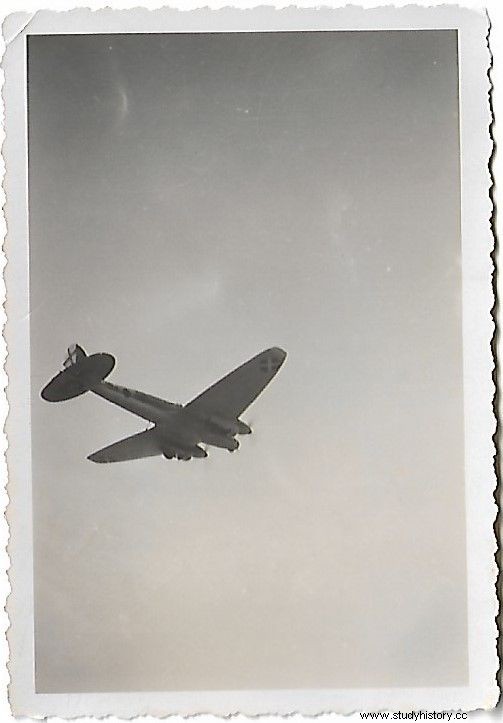
Características técnicas del Heinkel 111 E-3:
- Envergadura:22,61 m; Longitud:17,51 m; Altura:4,20 m; Superficie alar:86,50 m2
- Techo operativo:8000 m; Velocidad:420 km/h a 5000 m; Autonomía:1065 km
- Motores:2 Jumo 211 de 1100 cv
- Armamento:3 ametralladoras MG 15 de 7,92 mm y 1500 kg de bombas
- Tripulación:piloto, navegante/bombardero/artillero frontal, artillero ventral, operador de radio/artillero dorsal
Junkers Ju 52/3m “Pablo”
Al igual que el He 111, este aparato trimotor fue creado para su uso por parte de las aerolíneas germanas. Con un diseño caracterizado por su revestimiento corrugado el primer Ju 52/1m tomo vuelo el 13 de octubre de 1930. Un año después se inician los trabajos que darán lugar a su perfil trimotor con el Junkers Ju 52/3m que posteriormente tendrá su desarrollo como versión militar en el Ju 52/3mge y posteriormente a un mejorado Ju 52/3mg3e. Estas conversiones militares apenas variaban su estructura por lo cual se conseguía su fabricación sin modificar sustancialmente las líneas de montaje.
En la Guerra Civil tuvieron un papel destacado en el transporte de las tropas del norte de África a la península y se convirtieron a la llegada de la Legión Cóndor en la espina dorsal de su fuerza de bombarderos. La aparición de cazas más capaces en la aviación republicana pronto sacó a la luz sus limitaciones de velocidad y armamento defensivo, obligándolos a realizar tareas de bombardeo nocturno y transporte. Tras el envío de los He 111 y Do 17, los supervivientes fueron entregados a la aviación nacional donde siguieran en uso hasta el fin de la contienda. En 1942 CASA adquiere la licencia de fabricación dando lugar al CASA C-352L y la designación militar T.2. Con un total de 170 aparatos producidos como transportes llegaran a participar en el conflicto por Ifni de 1957-1958 y permanecerán en uso hasta los años 70.
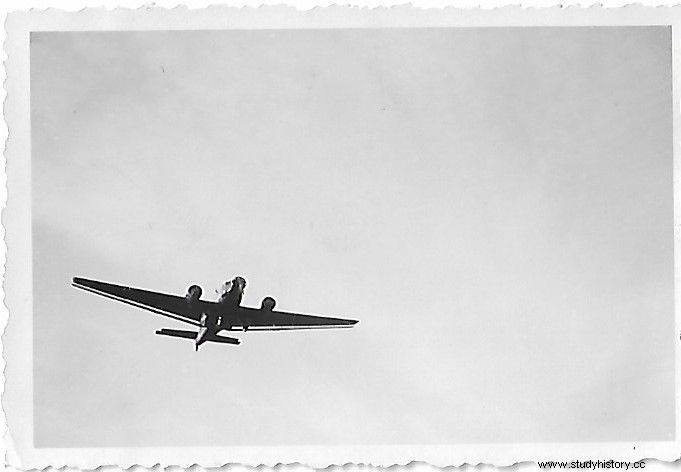
Características técnicas del Junkers Ju 52/3m
- Envergadura:29,25 m; Longitud:18,90 m; Altura:5,55 m; Superficie alar:110,50 m2
- Techo operativo:5900 m; Velocidad:275 Km/h a 900 m; Autonomía:1300 km
- Motores:3 BMW 132 A3 de 750 cv
- Armamento:2 ametralladoras MG 15 de 7,92 mm y 500 kg de bombas
- Tripulación:4
Dornier Do 17 E y F “Bacalao”
De líneas estilizadas su diseño como avión civil de alta velocidad sería un desastre pero no así sus prototipos militares que pronto le ganaron el apodo de Fliegender Bleistift , el lápiz volador. Rápido para los estándares de la época, el Do 17E-1 entró en producción con dos MG 15, defensa trasera dorsal y ventral, además de capacidad para 750 kg de bombas. Le seguiría la versión de reconocimiento, la F1, enviada a España en abril de 1937 para sustituir a los He 70 F entregados a los nacionales. A mediados de 1938 los Dornier E y F supervivientes pasaran a manos españolas siendo reemplazados por los más capaces Do 17 P. Estos modelos permanecerán en servicio en la aviación nacional de postguerra hasta finales de los años 40.
Características técnicas del Dornier Do 17 E
- Envergadura:18,00 m; Longitud:16,25 m; Altura:4,32 m; Superficie alar:55,00 m2
- Techo operativo:5500 m; Velocidad máxima:355 km/h; Autonomía:1590 km
- Motores:2×BMW VI, V12 de 750 cv cada uno
- Armamento:2 o 3 ametralladoras MG 15 de 7,92 mm y 750 kg de bombas
- Tripulación:piloto, bombardero/artillero, artillero
Messerschmitt Me 109 B 2
Diseñado por el equipo de Willy Messerschmitt a principios de los 30, era diseñador jefe de la Bayerische Flugzeugwerke de ahí su prefijo Bf, fue uno de los primeros cazas que en su época incluían mejoras como una construcción monocasco y metálica, carlinga totalmente cerrada y un tren de aterrizaje retráctil. Finalizando 1936 varios prototipos son enviados a España para ser evaluados, los V3, V4 y V5, para ya abril de 1937 dotar a la II/JG88 con varios Me 109B. Con el tiempo todas las Stafflen del Jagdgruppe 88 se irían equipando con los modelos B, C, D y E obteniendo una valiosa experiencia en tácticas de combate que serían desarrolladas por hombres como Werner Mölders para su posterior uso durante la Segunda Guerra Mundial.
Al igual que los Heinkel España adquirirá la licencia para la fabricación del Me 109G-2 por la Hispano Aviación en su fábrica de Sevilla. Dos serán las versiones que sirvieron en nuestro Ejército del Aire diferenciándose básicamente en sus motores. Designados Hispano Aviación HA-1112-K1L Tripala e Hispano Aviación HA-1112-M1L Buchón. Estos últimos finalizaran su servicio en 1965 y participarán en el rodaje de la película La batalla de Inglaterra caracterizados como sus abuelos alemanes de 1940.
Características técnicas del Messerschmitt Me 109 B2
- Envergadura:9,87 m; Longitud:8,55 m; Altura:2,45 m; Superficie alar:16,17 m2
- Techo operativo:8200 m; Velocidad máxima:465 km/h a 4500 m; Autonomía:690 km
- Motor:Jumo 210 Da con 720 cv
- Armamento:2 ametralladoras MG 17 de 7,92 mm
- Tripulación:piloto
